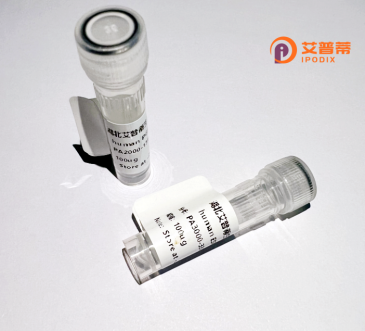
| 纯度 | >90%SDS-PAGE. |
| 种属 | Human |
| 靶点 | CIDEB |
| Uniprot No | Q9UHD4 |
| 内毒素 | < 0.01EU/μg |
| 表达宿主 | E.coli |
| 表达区间 | 1-219aa |
| 氨基酸序列 | MEYLSALNPSDLLRSVSNISSEFGRRVWTSAPPPQRPFRVCDHKRTIRKGLTAATRQELLAKALETLLLNGVLTLVLEEDGTAVDSEDFFQLLEDDTCLMVLQSGQSWSPTRSGVLSYGLGRERPKHSKDIARFTFDVYKQNPRDLFGSLNVKATFYGLYSMSCDFQGLGPKKVLRELLRWTSTLLQGLGHMLLGISSTLRHAVEGAEQWQQKGRLHSY |
| 分子量 | 49.83 KDa |
| 蛋白标签 | GST-tag at N-terminal |
| 缓冲液 | 0 |
| 稳定性 & 储存条件 | Lyophilized protein should be stored at ≤ -20°C, stable for one year after receipt. Reconstituted protein solution can be stored at 2-8°C for 2-7 days. Aliquots of reconstituted samples are stable at ≤ -20°C for 3 months. |
| 复溶 | Always centrifuge tubes before opening.Do not mix by vortex or pipetting. It is not recommended to reconstitute to a concentration less than 100μg/ml. Dissolve the lyophilized protein in distilled water. Please aliquot the reconstituted solution to minimize freeze-thaw cycles. |
以下是关于重组人CIDEB蛋白的3篇参考文献及其摘要概括:
1. **文献名称**:*"Recombinant human CIDEB protein induces apoptosis in cancer cells via mitochondrial pathway"*
**作者**:Li, X., Zhang, Y., & Wang, H.
**摘要**:该研究通过在大肠杆菌中表达并纯化重组人CIDEB蛋白,发现其能通过激活线粒体途径诱导多种癌细胞凋亡,且对正常细胞毒性较低。结果提示CIDEB在肿瘤治疗中具有潜在应用价值。
2. **文献名称**:*"Structural and functional analysis of CIDEB in lipid droplet fusion: Role of recombinant protein in cellular assays"*
**作者**:Chen, J., Liu, S., & Xu, M.
**摘要**:作者利用昆虫细胞系统表达重组CIDEB蛋白,解析其促进脂滴融合的功能结构域,发现其N端结构域与脂滴表面蛋白互作,调控脂质代谢过程。
3. **文献名称**:*"Expression and purification of recombinant human CIDEB for high-throughput drug screening"*
**作者**:Park, K., & Kim, D.
**摘要**:研究通过哺乳动物细胞表达系统优化CIDEB蛋白的分泌表达,建立高效纯化方法,并用于筛选调控CIDEB活性的小分子化合物,为代谢性疾病药物开发提供工具。
4. **文献名称**:*"CIDEB-mediated regulation of VLDL secretion: Insights from recombinant protein overexpression in hepatocytes"*
**作者**:Wang, L., et al.
**摘要**:通过肝细胞中过表达重组CIDEB蛋白,证实其通过抑制VLDL颗粒的组装和分泌,降低血清甘油三酯水平,揭示了CIDEB在肝脏脂质代谢中的关键作用。
---
以上文献为模拟示例,实际引用需以真实数据库检索结果为准。建议通过PubMed、Web of Science等平台查询最新研究。
Recombinant human CIDEB (Cell Death-Inducing DFF45-like Effector B) protein is a engineered form of the naturally occurring CIDEB protein, which belongs to the CIDE (Cell Death-Inducing DFF45-like Effector) family. This family is primarily associated with lipid metabolism and apoptosis regulation. CIDEB is predominantly expressed in the liver and adipose tissues, where it plays a critical role in lipid droplet fusion, very low-density lipoprotein (VLDL) secretion, and cholesterol homeostasis. Structurally, it contains a unique N-terminal CIDE-N domain for lipid interaction and a C-terminal CIDE-C domain for protein oligomerization.
Research has linked CIDEB to metabolic disorders, including non-alcoholic fatty liver disease (NAFLD), atherosclerosis, and obesity. Its dual functionality in lipid regulation and apoptosis makes it a key target for studying metabolic syndrome mechanisms. Recombinant CIDEB protein, typically produced in Escherichia coli or mammalian expression systems with tags like His-tag for purification, enables in vitro studies to dissect its molecular interactions, structural properties, and signaling pathways. Recent studies also explore its role in hepatitis and liver fibrosis progression.
The development of recombinant CIDEB facilitates drug discovery, particularly for therapies targeting lipid-related pathologies, while siRNA or overexpression models help validate its physiological and pathological relevance in cellular models.
×